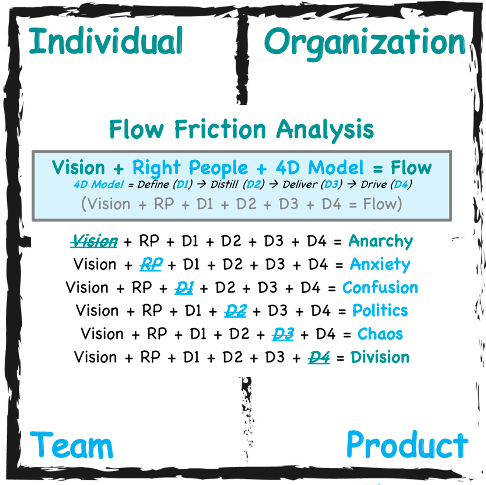The Flow Friction Analysis is simple. And it is one of the few ways in any framework, anywhere, that can identify friction.
We can measure friction (both positive and negative) in your teams and organizations. When you take this mindset out of the books and videos, you will end up living and breathing it since:
You use the Flow Friction Analysis to quickly identify, mitigate, and eliminate unwanted friction in your teams and organization.
The Flow Friction Analysis
The third part of this series is Tile 3, the Flow Friction Analysis:

There are two teach-backs on the Friction Analysis one with Bob Geist, FCT and the other with Jeff Kissinger, FCT (click links to see the teach-backs on this topic). We will go through each item in the table above (in this post) with a brief explanation and how to use it, every day.
Anarchy
Usually as result of having no Vision (or, the Vision is so poorly written that it ends up being unusable). People have cast off restraint and are doing what is right in their own eyes. If you are seeing anarchy, then you need to focus on clarifying the Vision to a point where it is usable.
Anxiety
This happens often when either an individual realizes that they are not the right person for a team, or that someone else on the team is not a good fit. There are other sources of anxiety that can be the result of mental, spiritual, physical, emotional, and/or social factors. If you have anxious teammates, then you need to get to the root cause.
Confusion
In the absence of clear Definitions, confusion reigns supreme. Definitions will make, or break, whatever Product, Service, and/or Result that you are trying to Deliver to your customer. It’s amazing how semantics can spin and individual, team, project, program, process, department, etc., right off the table. If you are seeing, hearing, sensing confusion, then you need to revisit your Definitions.
Politics
This is a tough one, especially for many Agilists. I’ve seen more than one Agilist throw up their hands and turn tail and run due to organizational politics. It’s a blood sport and not for the lighthearted. If you want to mitigate the politics (or potential groupthink), then you need to carefully Distill Agreement, both inside and outside of the team. This is the only countermeasure I know of that successfully works in this arena.
Chaos
This reminds me of an organization with which I worked many years ago. Their idea of doing a release was to lock all 50+ developers in a hotel conference room during a weekend, yell at each other, and they release a version plagued by bugs. It was incredibly stressful for those teams and the level of chaos was off the charts. If you want to avoid chaotic Deliveries, then you’d better do the Definition and Distillation parts of the equation correctly.
Division
This occurs when senior stakeholders and executive leadership are not united in the direction that they either want or need to go as an organization. The word “division” means “two visions” in English. This isn’t a problem since each department in an organization is going to have its own “vision.” The trick is to explicitly link the departmental vision back to the overall Vision for the organization. It’s the explicit link-back that most organizations miss doing. If you have division, then you will also have politics. If you want to mitigate the negative effects and friction that is caused by division, then you need to have clear visions at the department level that are linked-back to the main Vision. This is one of the easiest to understand, yet most difficult mindsets to achieve in Flow.
The value-add of having battle scarred veterans train, coach, and mentor your organization and teams should not be underestimated.
Finally, remember to baseline and then regularly measure (and report on) the friction that is manifesting in your teams.
Additional materials on the Friction Analysis
The Flow Friction Analysis gives you a powerful way to communicate to your teams, leadership, and executives.
The 18 Tiles
The third tile, the Flow Friction Analysis, as shared above is the third of eighteen areas on which we focus in the Flow Leadership Framework and Mindset. In subsequent posts I will be walking you through how to implement the remaining tiles to deliver outstanding and remarkable results, every day.

Three down, fifteen to go!
Focus Led Organizations Win!
Flow is methodology agnostic and will deliver consistent, remarkable results regardless of what’s being used at the individual, team, and product levels in an organization. That’s been proven over-and-over again during the past 26+ years on assignments in Europe, North America, and Asia.
So, why is it that you aren’t using Flow yet?
__________
For those that are not familiar with the Flow Leadership Framework & Mindset, it is what’s next for businesses and organizations that are ready to succeed regardless of the methods, frameworks, mindsets, or management tools that they use throughout their enterprise. Flow is methodology agnostic.
Are you ‘in the zone’ of optimal performance right now as a person, team or enterprise? Did you get there by accident or by focused intentional acts?
“Flow” gives you the way of working and mindset needed to create and maintain an optimal state of high performance as an individual, team or organization.
The Flow Leadership Framework turbocharges everything you do, including “business agile” leadership and Scaled Agile.
__________
PS Here are the associated links to this blog post for:
#culture #scrum #agile #pmi #pmp #kanban #lean #flow #scaledagile #transformation #change #transform #leadership #digitaltrasformation #changemanagement #safeagilist #flowleadership #futureofwork #innovation